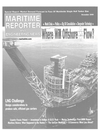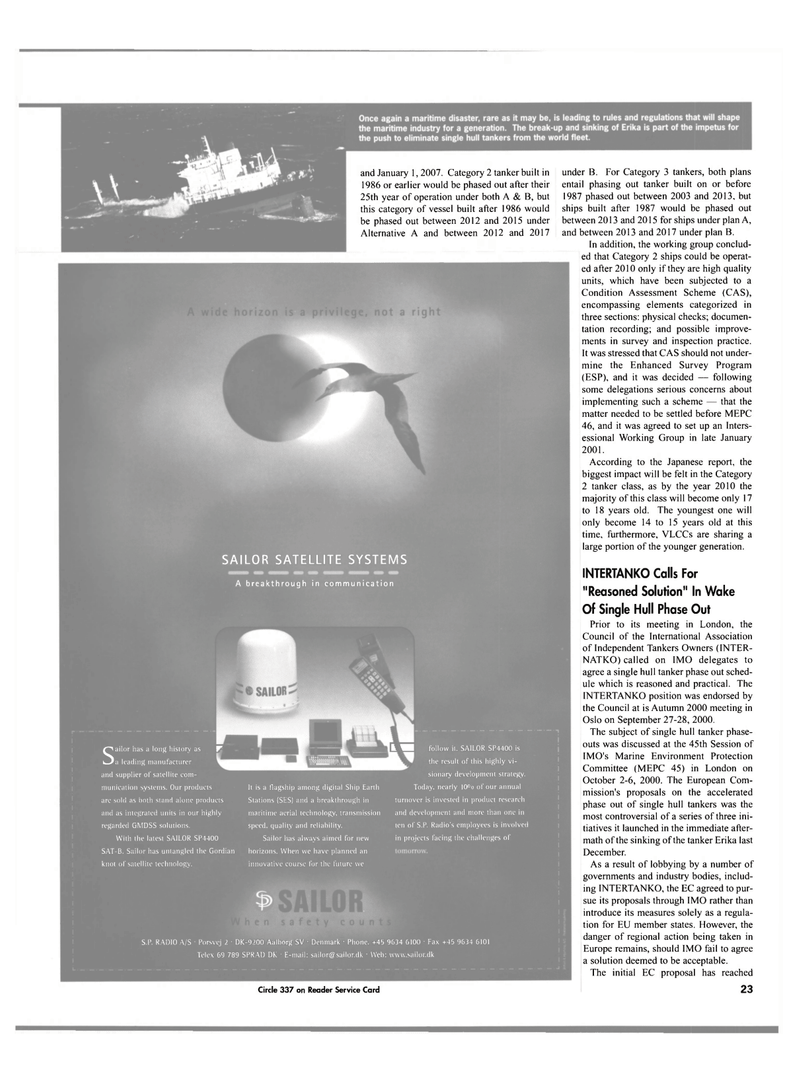
Page 25: of Maritime Reporter Magazine (November 2000)
Read this page in Pdf, Flash or Html5 edition of November 2000 Maritime Reporter Magazine
and January 1,2007. Category 2 tanker built in 1986 or earlier would be phased out after their 25th year of operation under both A & B, but this category of vessel built after 1986 would be phased out between 2012 and 2015 under
Alternative A and between 2012 and 2017
SAILOR SATELLITE SYSTEMS
A breakthrough in communication
Sailor has a long history as P a leading manufacturer and supplier of satellite com- munication systems. Our products are sold as both stand alone products and as integrated units in our highly regarded GMDSS solutions.
With the latest SAILOR SP4400
SAT-B. Sailor has untangled the Gordian knot of satellite technology.
It is a flagship among digital Ship Earth
Stations (SES) and a breakthrough in maritime aerial technology, transmission speed, quality and reliability.
Sailor has always aimed for new horizons. When we have planned an innovative course for the future we
LW follow it. SAILOR SP4400 is the result of this highly vi- sionary development strategy.
Today, nearly 10°b of our annual turnover is invested in product research and development and more than one in ten of S.P. Radio's employees is involved in projects facing the challenges of
S.P. RADIO A/S • Porsvej 2 • DK-9200 Aalborg SV • Denmark • Phone. +45 9634 6100 • Fax +45 9634 6101
Telex 69 789 SPRAD DK • E-mail: [email protected] • Web: www.sailor.dk
Circle 337 on Reader Service Card under B. For Category 3 tankers, both plans entail phasing out tanker built on or before 1987 phased out between 2003 and 2013, but ships built after 1987 would be phased out between 2013 and 2015 for ships under plan A, and between 2013 and 2017 under plan B.
In addition, the working group conclud- ed that Category 2 ships could be operat- ed after 2010 only if they are high quality units, which have been subjected to a
Condition Assessment Scheme (CAS), encompassing elements categorized in three sections: physical checks; documen- tation recording; and possible improve- ments in survey and inspection practice.
It was stressed that CAS should not under- mine the Enhanced Survey Program (ESP), and it was decided - following some delegations serious concerns about implementing such a scheme — that the matter needed to be settled before MEPC 46, and it was agreed to set up an Inters- essional Working Group in late January 2001.
According to the Japanese report, the biggest impact will be felt in the Category 2 tanker class, as by the year 2010 the majority of this class will become only 17 to 18 years old. The youngest one will only become 14 to 15 years old at this time, furthermore, VLCCs are sharing a large portion of the younger generation.
INTERTANKO Calls For "Reasoned Solution" In Wake
Of Single Hull Phase Out
Prior to its meeting in London, the
Council of the International Association of Independent Tankers Owners (INTER-
NATKO) called on IMO delegates to agree a single hull tanker phase out sched- ule which is reasoned and practical. The
INTERTANKO position was endorsed by the Council at is Autumn 2000 meeting in
Oslo on September 27-28, 2000.
The subject of single hull tanker phase- outs was discussed at the 45th Session of
IMO's Marine Environment Protection
Committee (MEPC 45) in London on
October 2-6, 2000. The European Com- mission's proposals on the accelerated phase out of single hull tankers was the most controversial of a series of three ini- tiatives it launched in the immediate after- math of the sinking of the tanker Erika last
December.
As a result of lobbying by a number of governments and industry bodies, includ- ing INTERTANKO, the EC agreed to pur- sue its proposals through IMO rather than introduce its measures solely as a regula- tion for EU member states. However, the danger of regional action being taken in
Europe remains, should IMO fail to agree a solution deemed to be acceptable.
The initial EC proposal has reached 23

 24
24

 26
26
